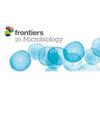严重发热伴血小板减少综合征患者侵袭性肺曲霉菌病的相关临床因素:6 年临床经验分析
IF 4
2区 生物学
Q2 MICROBIOLOGY
引用次数: 0
摘要
背景侵袭性肺曲霉菌病(IPA)通常发生在免疫力低下的人身上。严重发热伴血小板减少综合征(SFTS)患者的典型特征是发热、血小板减少和白细胞减少。这些患者通常表现为细胞免疫和体液免疫失调,这可能使他们易患 IPA。我们的研究旨在确定SFTS相关侵袭性肺曲霉菌病(SAPA)的风险因素,并评估其对预后的相关影响。方法我们于2017年1月至2022年12月在武汉市一家三级甲等医院开展了一项队列研究。根据患者是否合并曲霉菌感染,将所有在我科住院并获得正式同意的SFTS患者分为SAPA组和非SAPA组。通过多变量逻辑回归确定了SAPA组的独立危险因素。受试者操作特征(ROC)分析用于评估预测SAPA患者参数的统计学价值。结果 在269例住院SFTS患者中,118例(43.87%)被确诊为SAPA,平均年龄为(65.71±9.7)岁。多变量逻辑回归分析显示,年龄、神经系统并发症、血清严重发热伴血小板减少综合征病毒(SFTSV)RNA载量、白细胞(WBC)计数、血小板(PLT)计数、白蛋白(ALB)和球蛋白(GLB)浓度以及心肌肌钙蛋白I(cTNI)是SFTS患者发生IPA的辅助风险因素。风险评分的计算公式为:年龄 5 倍,神经系统并发症 6 倍,RNA(对数)10 倍,WBC 5 倍,PLT 5 倍,ALB 5 倍,GLB 5 倍,cTNI 6 倍。ROC曲线分析显示,接收者操作特征曲线下面积(AUROC)代表了预测SFTS患者IPA的风险评分为0.837(95% CI:0.789-0.885,p &p;lt;0.001)。SAPA组的平均住院时间比非SAPA组更长。SAPA组和非SAPA组的死亡率明显不同:结论患有IPA的SFTS患者发病率和死亡率都很高。早期监测SFTS患者的神经系统并发症、SFTSV RNA载量、白细胞、PLT、ALB、GLB和cTNI可能有助于预测IPA的发生。本文章由计算机程序翻译,如有差异,请以英文原文为准。
Clinical factors associated with invasive pulmonary aspergillosis in patients with severe fever with thrombocytopenia syndrome: analysis of a 6-year clinical experience
BackgroundInvasive pulmonary aspergillosis (IPA) typically occurs in immunocompromised individuals. Severe fever with thrombocytopenia syndrome (SFTS) patients are typically characterized by fever, thrombocytopenia, and leukopenia. These patients typically present with dysregulation of cellular and humoral immunity, which may predispose them to IPA. Our study aimed to identify risk factors for SFTS-associated invasive pulmonary aspergillosis (SAPA) and evaluate its associated prognostic impact.MethodsWe conducted a cohort study between January 2017 and December 2022 in a tertiary hospital in Wuhan City, China. All SFTS patients hospitalized in our department who formally consented were divided into a SAPA group and a non-SAPA group according to whether they were coinfected with aspergillosis or not. The independent risk factors for the SAPA group were determined by multivariate logistic regression. Receiver operating characteristic (ROC) analysis was used to assess the statistical value of parameters to predict SAPA patients. The survival analysis was carried out using the Kaplan–Meier (KM) method.ResultsOf the 269 hospitalized SFTS patients enrolled in the study, 118 (43.87%) cases were diagnosed with SAPA with an average age of 65.71 ± 9.7 years. Multivariate logistic regression analysis revealed that age, neurological complications, serum severe fever with thrombocytopenia syndrome virus (SFTSV) RNA loads, the white blood cell (WBC) count, platelet (PLT) count, albumin (ALB) and globulin (GLB) concentrations, and cardiac troponin I (cTNI) were complementary risk factors for the development of IPA in SFTS patients. The risk score is calculated as 5 times age, plus 6 times neurological complications, plus 10 times RNA (log), plus 5 times WBC, minus 5 times PLT, minus 5 times ALB, plus 5 times GLB, and plus 6 times cTNI. ROC curve analysis showed that the area under the receiver operating characteristic (AUROC) curve represented a risk score of 0.837 (95% CI : 0.789–0.885, p < 0.001) for predicting IPA in SFTS patients. The average length of hospitalization in the SAPA group was more prolonged than non-SAPA. SAPA and non-SAPA groups had significantly different mortality rates: 25.42% (SAPA) and 3.97% (non-SAPA) (p < 0.05).ConclusionSFTS patients with IPA have high morbidity and mortality. Early monitoring of neurological complications, SFTSV RNA loads, WBC, PLT, ALB, GLB, and cTNI in SFTS patients may be useful in predicting the occurrence of IPA.
求助全文
通过发布文献求助,成功后即可免费获取论文全文。
去求助
来源期刊

Frontiers in Microbiology
MICROBIOLOGY-
CiteScore
7.70
自引率
9.60%
发文量
4837
审稿时长
14 weeks
期刊介绍:
Frontiers in Microbiology is a leading journal in its field, publishing rigorously peer-reviewed research across the entire spectrum of microbiology. Field Chief Editor Martin G. Klotz at Washington State University is supported by an outstanding Editorial Board of international researchers. This multidisciplinary open-access journal is at the forefront of disseminating and communicating scientific knowledge and impactful discoveries to researchers, academics, clinicians and the public worldwide.
 求助内容:
求助内容: 应助结果提醒方式:
应助结果提醒方式:


